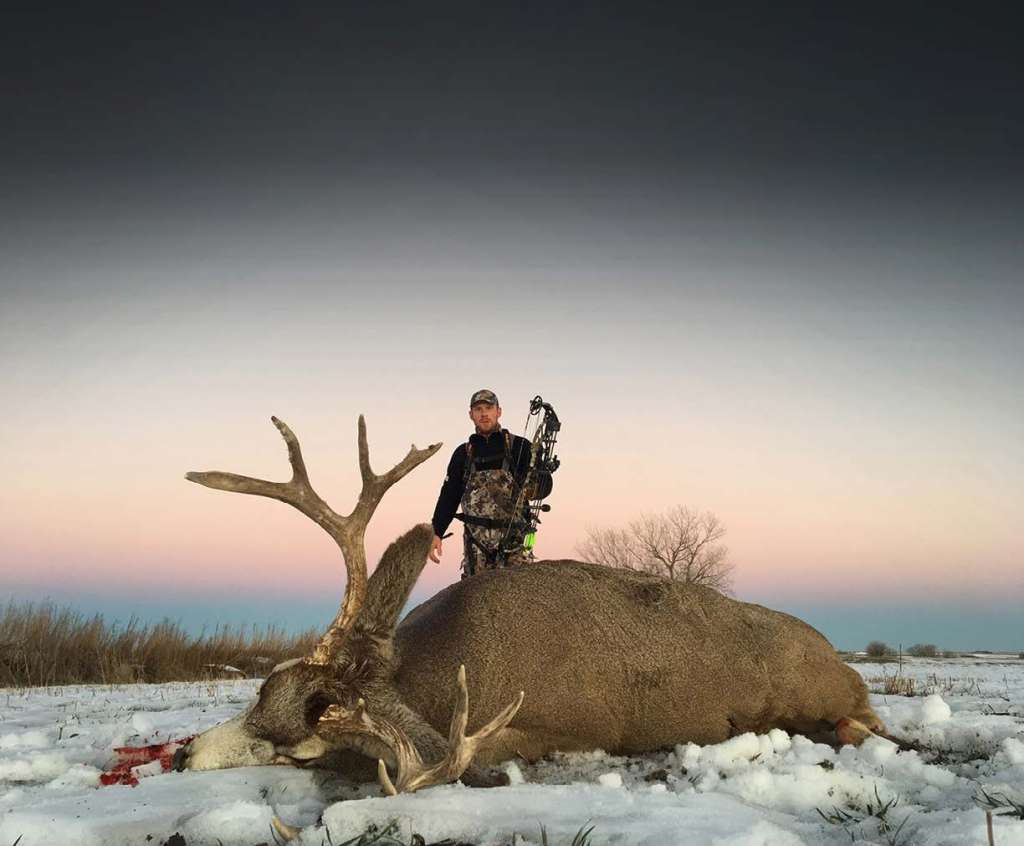Don’t overlook the effectiveness of an elevated ambush.
That day, you could’ve heard a pin drop—which is a rarity on the normally gusty South Dakota prairies.
Dawn cracked slowly that November morning, and with the onset of legal shooting light came the rustling of an approaching deer. I was hunting 20 feet up the only tree large enough to hold a treestand in a little thicket I’d found the previous day with trails intersecting in multiple places out front. My pulse quickened as I stood, lifted my bow from its hook, and studied the brush for an emerging buck.
When the brush parted, a buck appeared that any sane bowhunter would be proud to take, especially on public land. I prepared to draw my bow, for he was about to enter an opening exactly 30 yards away. Suddenly, a north wind whipped the back of my neck. The buck hit the brakes, paused momentarily, then bounded away.
Success had been so close; only a small juniper had blocked his vitals. But the notable part of the hunt was that I had a mature buck within easy range on my first attempt at bowhunting mule deer from a treestand. Maybe I was onto something.
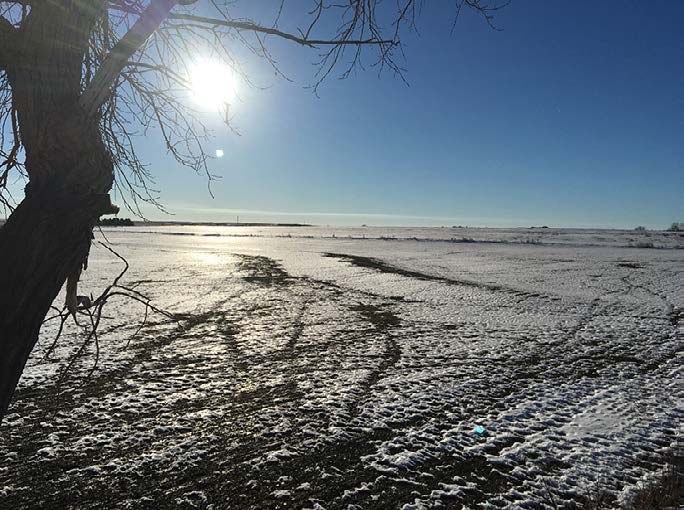
Pack a Stand
The typically open habitat that muleys roam lends itself to the spot-and-stalk strategy. Further, mule deer are traditionally more difficult to pattern than their Whitetail cousins. Thus, few folks pack a treestand or two when embarking on a mule deer hunt. However, a treestand can be very useful given the right circumstances. So, think twice before you leave home without one.
Yes, circumstances must align in order for a treestand hunt to be productive. I mean, I’ve only sat in treestands about 10 times for mule deer, but I’ve had mature bucks within bow range on four of those 10 sits. That’s a very good percentage, and it’s why I carry a treestand to mule deer country.
To that end, let’s discuss some instances in which hunting muleys from a treestand can be productive.
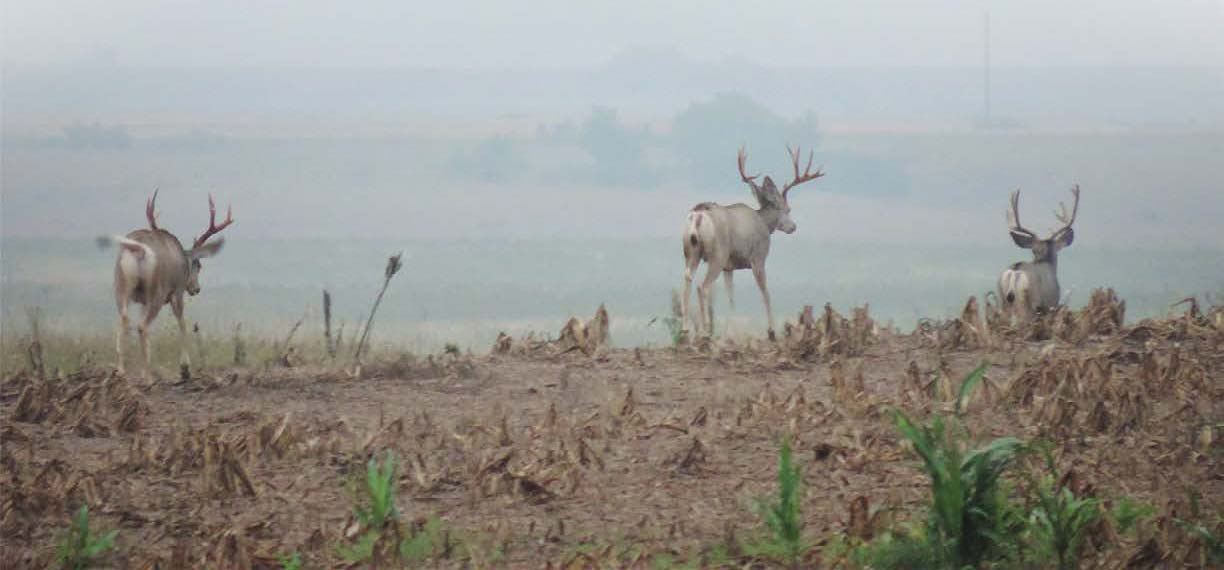
Identify the Opportunities
First, some of the best opportunities to bowhunt muleys from treestands occur where wooded draws connect to agriculture. Muleys in farmland habitat don’t necessarily eat on fields every single day, but during a five-day hunt, they’re liable to do so. When fields are picked, mule deer will generally bed in draws or prairies adjacent to crops, so you’ll want to try to identify draws leading from one to the other. If a tree that can hold a treestand is available, consider hunting there for a few days.
Such a stand produced a large, non-typical mule deer for my brother just several years ago. During the rut, he hunted the mouth of a draw right where it connects to a large hayfield. The bruiser came cruising through looking for does and the stationary treestand ambush proved deadly on the monarch.
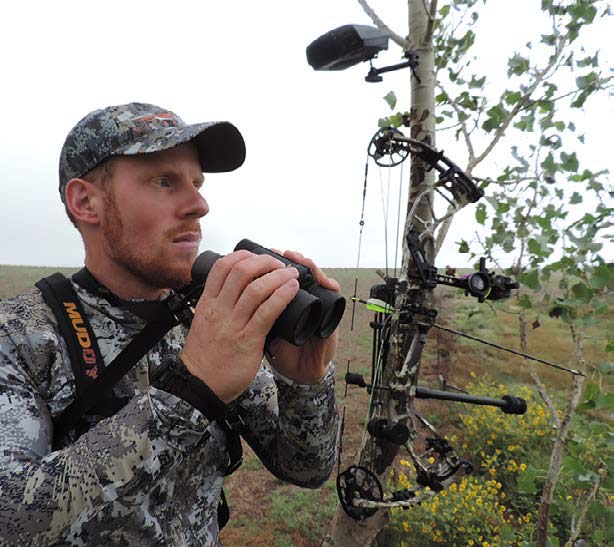
On a late-season hunt in Nebraska, I identified a draw about 150 yards from a standing cornfield. Twice, I observed deer staging among the trees in that draw prior to hitting the cornfield. So, with the temperatures well below zero one afternoon, I stuffed body warmers in every nook and cranny and bundled up. I hung a stand as quickly as possible, then endured the brutal conditions, with winds whipping at 20 to 30 miles per hour.
A fawn and then a nice, mature 5 x 5 came up the draw behind me. I took a shot at the buck when he stepped out in front of me, but my arrow passed over his back. I’d had the distance wrong. Nonetheless, the treestand ambush provided me with an opportunity in a scenario where spotting and stalking wouldn’t have been effective.
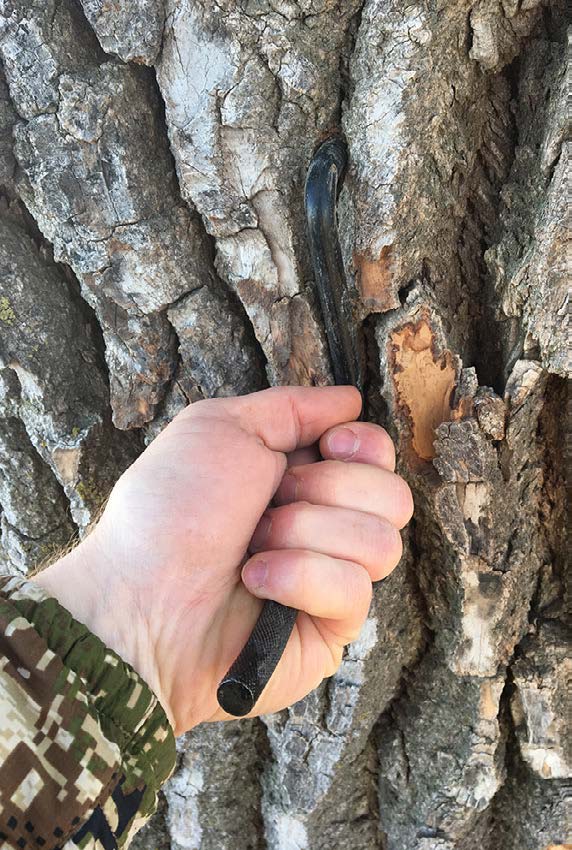
Look for Saddles
The second scenario where treestands can be killer in mule deer country is when you identify a saddle that the deer are using. Large muley bucks don’t usually expose themselves on wide-open ridge tops, and that’s why a saddle can be a great ambush location. Hunt it for the first and last hours of daylight anytime in the season. But hunt it all day during the rut if deer sign suggests that it’s being frequently used.
On the morning when I encountered the buck I mentioned at the start of this article, a friend had been hunting a distance away. Interestingly, he observed two le deer bucks using a saddle about 200 yards from my stand. So, don’t overlook saddles.
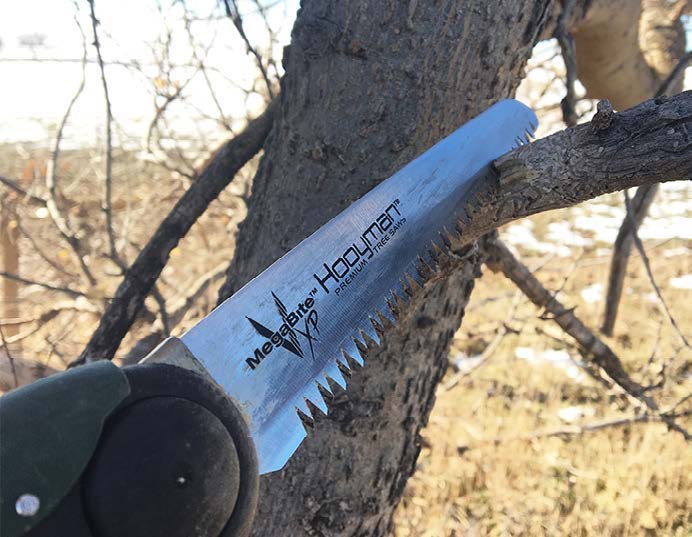
tree for shooting and a Hooyman extendable saw
made this work possible Photo by Darron McDougal
Third, hunt directly on a food source when it makes sense. During the early season, this can be slightly difficult due to standing crops, but it’s still doable. Then, from the pre-rut through late season, deer in prairie habitat are known to herd up and concentrate on food sources, such as corn, hay, wheat, and other crops. I’ve observed deer spending nearly all day in these types of food sources in ranch country during the rut. And in the late season, I’ve seen them consistently spend the mornings and evenings there.
During a Nebraska archery hunt in September that began as a spot-and-stalk hunt, I watched some bucks move from a standing cornfield to a nearby draw. A lone aspen tree intersected with their travel route, so I quickly hung a stand there. I nearly had an opportunity at a bachelor group of bucks, but they swung wider than I anticipated, hitting my downwind airstream and re-routing. I also spotted two world-class bucks from that treestand on the final evening of the hunt.
I returned to the same area in December. A recent snowfall event and crusty snow eliminated stalking as an option. So, I drove around the property trying to identify possible treestand and ground-blind ambush locations.
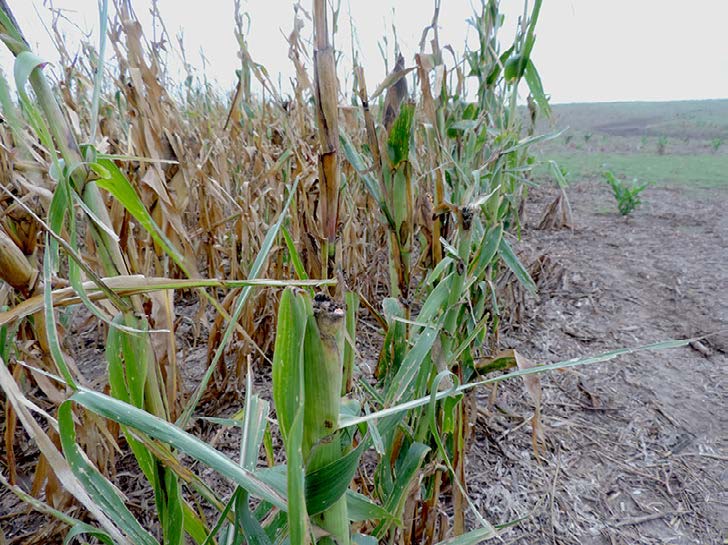
Just One Cottonwood
Soon, I spotted a lone cottonwood tree in the middle of a winter-wheat field. Upon closer inspection, I noticed that snow had melted away on the tree’s south side, exposing patches of green winter wheat. Deer were obviously hitting these easy pickings, as deep drifts everywhere else made grazing nearly impossible. Trails converged on the scene from multiple directions. With some monkey-like maneuvers, I hung a stand, positioned my Ozonics HR-300 unit and then began hunting for the afternoon.
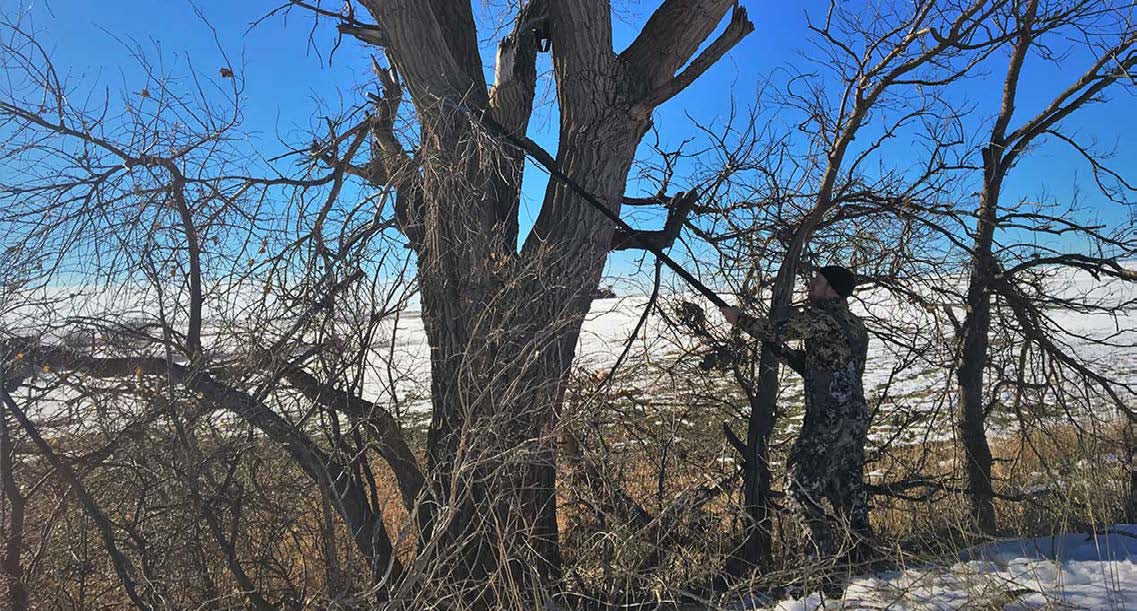
this work possible Photo by Darron McDougal
About 45 minutes before dark, two dots appeared on the horizon several hundred yards away. My binoculars confirmed that two bucks, about 500 yards away, were meandering my way. In about 10 minutes, it was obvious that the bucks were thinking winter wheat as they ventured within 100 yards of my location. They were directly downwind as they came, but my Ozonics HR-300 covered my presence.
The smaller buck passed by at 40 yards and began feeding. The other buck was a slowpoke, but he caught up and also hit an open patch of winter wheat 44 yards away. My Rage-tipped arrow angled perfectly into the quartering-away buck, and he ran only 50 yards and slumped. I thanked God for the extremely cool opportunity to finally bow- kill a mule deer buck—and a good one— from a treestand.
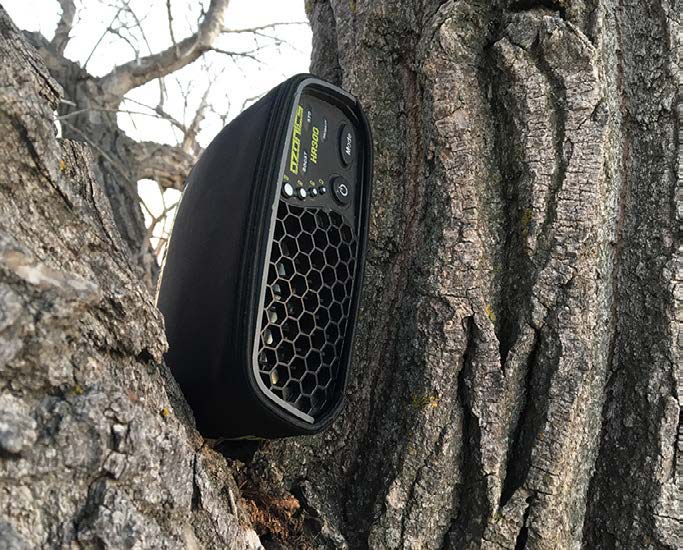
Climb a Tree
As I said earlier, mule deer are spot-and-stalk icons due to the open ground they inhabit. But, in select instances, a treestand ambush can put a quality buck within archery range. Pack a treestand on your mule deer hunts, then be attentive to opportunities in which hunting from a treestand offers advantages over spotting and stalking. It’s just another trick for your mule deer tool belt, and it could yield a beautiful buck as it did for me.
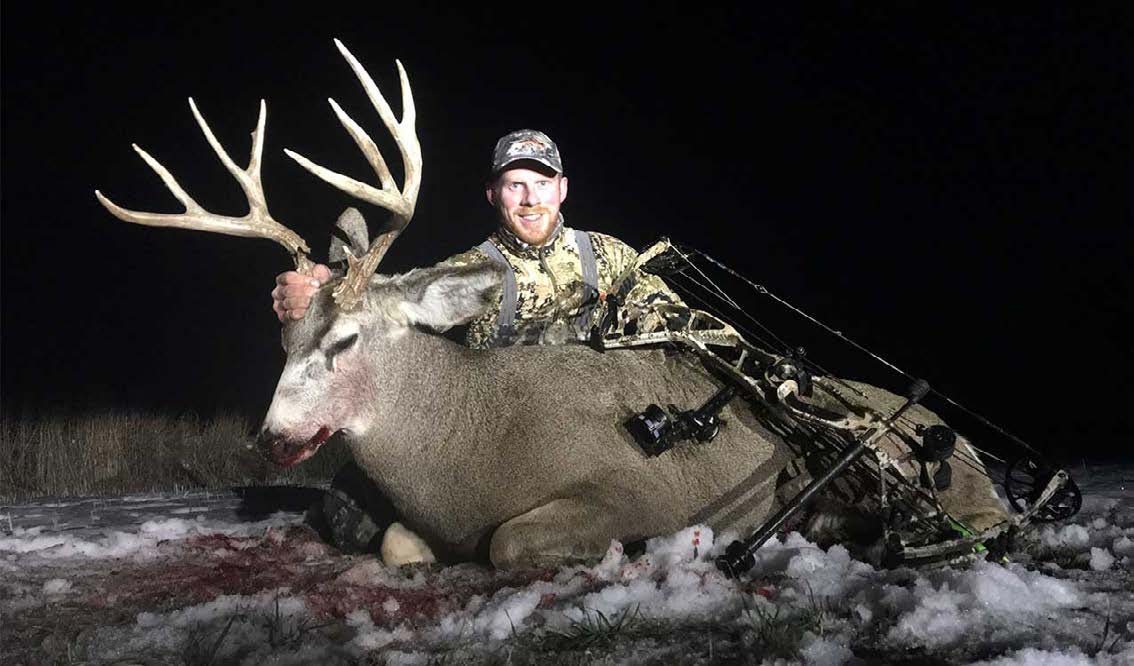
Per our affiliate disclosure, we may earn revenue from the products available on this page. To learn more about how we test gear, click here.





